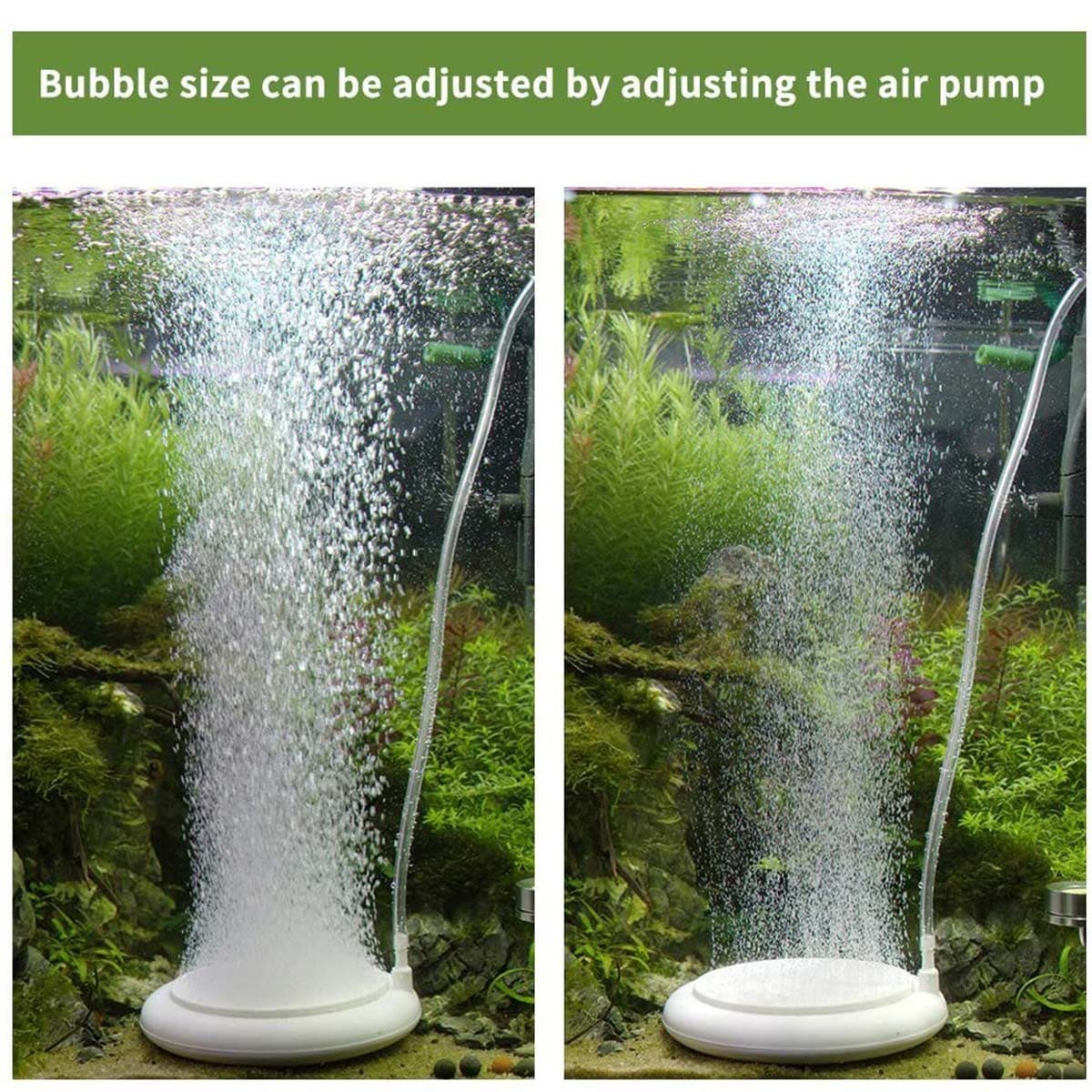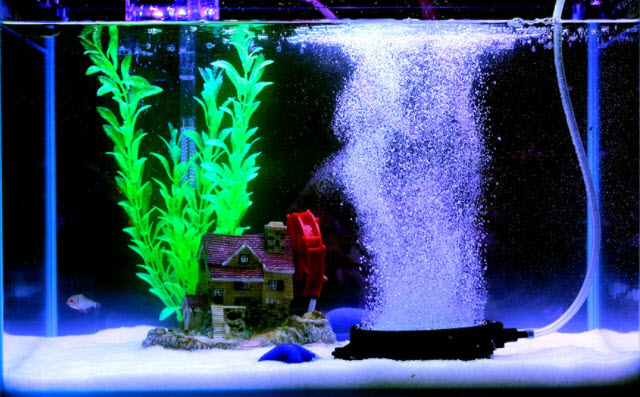An air stone is a porous device that diffuses air into an aquarium. It creates bubbles to improve oxygenation.
Air stones play a vital role in maintaining a healthy aquarium environment. They enhance water circulation and oxygen levels, benefiting fish and aquatic plants. Made from materials like limewood or porous stone, they attach to an air pump, producing a stream of fine bubbles.
This not only oxygenates the water but also helps in reducing carbon dioxide levels. Air stones come in various shapes and sizes to suit different tank setups. Their regular use ensures a stable, oxygen-rich habitat, which is crucial for the well-being of aquatic life. Investing in a quality air stone can significantly improve your aquarium’s overall health and aesthetics.
Introduction To Air Stones
An air stone is a small device used in aquariums. It helps to increase the oxygen levels in the water. They are essential for creating a healthy aquatic environment. Air stones are also known as bubble stones.
Purpose In Aquatic Environments
Air stones serve several important purposes in aquariums:
- Increase Oxygen Levels: They release tiny bubbles, improving water oxygenation.
- Enhance Water Movement: Bubbles create gentle currents, preventing water stagnation.
- Aesthetic Appeal: Bubbles add visual interest, making aquariums look lively.
Historical Background
The use of air stones dates back to the early 20th century. They were first developed for use in fish farms. Over time, hobbyists adopted them for home aquariums. Today, they are a standard component in many setups. The technology has evolved, but the basic principle remains the same.
The Science Of Oxygenation
The science of oxygenation is essential for healthy aquatic environments. Understanding how air stones contribute helps maintain vibrant fish and plant life. Let’s explore the science behind this fascinating process.
Role Of Oxygen In Water
Oxygen is vital for all aquatic organisms. Fish need it to breathe, and beneficial bacteria require it to break down waste. Without enough oxygen, water quality deteriorates quickly.
In water, oxygen levels can deplete due to various factors. Overcrowding, overfeeding, and insufficient water movement are common causes. Maintaining proper oxygen levels ensures a healthy ecosystem for your aquarium.
| Factor | Impact on Oxygen Levels |
|---|---|
| Overcrowding | Increases demand for oxygen |
| Overfeeding | Leads to waste buildup |
| Insufficient Water Movement | Reduces oxygen exchange |
How Air Stones Work
Air stones are small devices that release air bubbles into water. These bubbles increase the surface area for oxygen exchange.
When air stones are connected to an air pump, they create a steady stream of bubbles. This process helps circulate the water and promotes gas exchange at the surface.
- Improves oxygen levels
- Enhances water circulation
- Aids in waste breakdown
Using air stones in your aquarium is simple. Place the air stone at the bottom, connect it to an air pump, and watch the bubbles rise. This simple setup can make a big difference in maintaining a healthy aquarium.
True
True
True
Types Of Air Stones
Air stones come in various types, each suitable for different needs. Understanding these types helps in selecting the right air stone for your aquarium.
Materials Used
Air stones are made from different materials. These materials affect their durability and performance. Here are some common materials used:
- Ceramic: Durable and provides fine bubbles.
- Plastic: Lightweight and budget-friendly.
- Wood: Often used in protein skimmers for saltwater tanks.
Shapes And Sizes
Air stones come in various shapes and sizes. Choosing the right shape and size ensures optimal aeration. Here are some common options:
| Shape | Description |
|---|---|
| Round | Ideal for even bubble distribution. |
| Bar | Perfect for long tanks, provides linear bubble flow. |
| Disc | Great for powerful aeration in larger tanks. |
Air stones also vary in size. Small air stones are suitable for small tanks. Larger air stones are ideal for bigger aquariums.
Setting Up Your Air Stone System
Setting up an air stone system can enhance your aquarium. This guide will help you install it correctly. Follow the steps below to ensure your system works efficiently.
Required Equipment
Before starting, gather all the necessary equipment. Here’s a list:
- Air Stone – The main component for aeration.
- Air Pump – Provides the needed air pressure.
- Airline Tubing – Connects the air stone to the air pump.
- Check Valve – Prevents water from flowing back into the pump.
- Suction Cups – Secures the tubing inside the tank.
- Scissors – For cutting the tubing to the desired length.
Step-by-step Installation
- Place the Air Pump: Position it outside the tank. It should be on a flat surface.
- Cut the Airline Tubing: Measure and cut the tubing to fit between the pump and the air stone.
- Connect the Tubing: Attach one end of the tubing to the air pump.
- Install the Check Valve: Insert it into the tubing. Ensure the arrow points towards the air stone.
- Attach the Air Stone: Connect the other end of the tubing to the air stone.
- Secure the Tubing: Use suction cups to attach the tubing inside the tank.
- Place the Air Stone: Position the air stone at the desired location inside the tank.
- Plug In the Air Pump: Turn on the air pump and check for bubbles from the air stone.
By following these steps, your air stone system should be set up and working efficiently. Enjoy the improved aeration and water quality in your aquarium.
Benefits Of Using Air Stones
Air stones offer numerous advantages for aquariums. They provide a healthier environment for aquatic life. Discover the key benefits below.
Healthier Aquatic Life
Air stones enhance oxygen levels in the water. This is crucial for fish and plants. More oxygen means fish breathe easier. Plants also benefit from increased oxygen. They grow faster and healthier.
Air stones create gentle water movement. This mimics natural habitats. Fish feel less stressed in moving water. It also prevents harmful gas buildup. Ammonia and carbon dioxide levels stay low.
Enhanced Water Clarity
Air stones help keep the water clear. They promote better filtration. Small bubbles carry debris to the filter. This reduces waste buildup in the tank.
Clear water means you see your fish better. It also showcases plant life. A clean tank is more attractive and healthy.
| Benefit | Description |
|---|---|
| Oxygenation | Increases oxygen levels for fish and plants. |
| Water Movement | Mimics natural habitats, reducing fish stress. |
| Filtration | Helps filter out debris, keeping water clean. |
- Improves fish breathing.
- Helps plants grow better.
- Reduces harmful gas levels.
- Makes the tank more attractive.

Credit: www.youtube.com
Maintenance And Care
Proper maintenance and care of an air stone ensure its efficiency and longevity. Regular upkeep prevents clogging and maintains optimal performance. Let’s explore the essential steps for air stone maintenance.
Cleaning Protocols
Regular cleaning keeps your air stone functioning well. Follow these simple steps:
- Remove the air stone from the tank.
- Rinse it under running water to remove debris.
- Soak it in a solution of water and bleach (1:10 ratio) for 30 minutes.
- Rinse thoroughly with clean water to remove any bleach residue.
- Allow it to air dry completely before reusing.
Troubleshooting Common Issues
Sometimes, your air stone may face issues. Here’s how to handle them:
- Reduced Bubble Output: Check for clogs and clean the air stone.
- No Bubbles: Ensure the air pump is working and connected properly.
- Uneven Bubbles: Soak the air stone in vinegar to dissolve mineral deposits.
Regular maintenance and troubleshooting keep your air stone in top shape. Follow these steps for a healthy aquarium environment.
Selecting The Right Air Stone
Choosing the right air stone for your aquarium is essential. The correct air stone ensures proper oxygenation and a healthy environment. This section will guide you through the factors to consider and recommendations by tank size.
Factors To Consider
- Size of the Aquarium: The size of your tank determines the air stone size.
- Air Pump Compatibility: Ensure the air stone matches your air pump’s output.
- Material: Air stones come in different materials like ceramic or wood. Choose one that suits your tank’s needs.
- Bubble Size: Different air stones produce different bubble sizes. Smaller bubbles mean better oxygenation.
- Durability: Opt for a durable air stone to avoid frequent replacements.
Recommendations By Tank Size
| Tank Size | Recommended Air Stone |
|---|---|
| Up to 10 Gallons | Small air stone (1-2 inches) |
| 10-20 Gallons | Medium air stone (3-4 inches) |
| 20-40 Gallons | Large air stone (5-6 inches) |
| 40+ Gallons | Extra-large air stone or multiple stones |
Choosing the right air stone is crucial for your tank’s health. Consider the factors listed and refer to the table for recommendations based on tank size.

Credit: www.hygger-online.com
Innovations And Future Trends
The world of air stones is evolving rapidly. New technologies and research are shaping the future. These innovations promise improved efficiency and functionality.
Latest Developments
Many new materials are being used to create air stones. One such material is ceramic, which is durable and efficient. Another exciting development is the integration of LED lights into air stones. These lights not only provide oxygen but also enhance the aquarium’s beauty.
Smart air stones are also emerging. These devices can be controlled via smartphones. They offer features like adjustable bubble size and real-time monitoring. This makes them highly user-friendly and efficient.
Here is a table summarizing the latest developments:
| Development | Benefits |
|---|---|
| Ceramic Air Stones | Durable and efficient |
| LED-Integrated Air Stones | Oxygenation and visual appeal |
| Smart Air Stones | Remote control and monitoring |
Research On Oxygenation
Scientists are focusing on improving oxygenation efficiency. Research shows that microbubbles can enhance oxygen levels. These tiny bubbles dissolve more quickly in water. This leads to better oxygen distribution.
Another area of research is nanotechnology. Nanoparticles can be used to create more effective air stones. These air stones can deliver oxygen more efficiently. They can also help in maintaining water quality.
Researchers are also studying the impact of different shapes and sizes of air stones. They are finding that certain shapes can improve oxygenation. This helps in creating a healthier environment for aquatic life.
Here are some key research areas:
- Microbubble Technology
- Nanotechnology in Air Stones
- Shape and Size Optimization

Credit: aquariumscience.org
Conclusion
An air stone is a crucial element for any aquarium. It boosts oxygen levels, ensuring a healthy environment for fish. By creating tiny bubbles, it improves water circulation and prevents stagnant areas. Investing in a quality air stone can significantly enhance your aquarium’s ecosystem, promoting vibrant aquatic life.
